
NOODLES
by Janet S. WongNoodles for breakfast,
Noodles for lunch,
Noodles for dinner,
Noodles that crunch,
Noodles to twirl,
Noodles to slurp–
I could eat noodles
all day! Burp!~ from Good Luck Gold (© 1994 Janet S. Wong). All rights reserved.
Pardon my burp, but I’ve just polished off a bowl of warm, steamy ramen — really hits the spot on a rainy Spring afternoon. Just like Janet, I love noodles at any time, any place; even just seeing the word “noodle” makes me happy.
Whether you’re talking about ramen, pho, guksu, pancit, lo mein, wonton, udon, yakisoba, saimin, japchae, chow fun, dandan, somen or any form of pasta — it’s all good. There’s nothing more comforting or satisfying than slurping up those long chewy strands of goodness with gravy, sauce or soup.
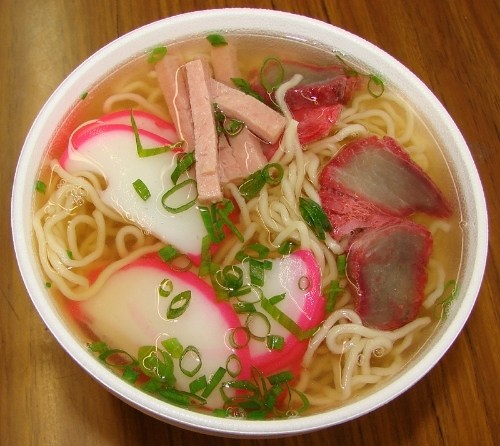
It’s almost like every time I eat a noodle dish I’m tasting part of my childhood — a savory bowl of saimin with teriyaki barbecue sticks at the Fred Wright Park carnival, Crispy Gau Gee Mein from Waimalu Chop Suey, cold guksu with my two grandmas at Seoul Inn, somen salad at beach picnics, or the wonderful Chinese noodles with char siu and vegetables my Auntie Ellen always made for family holiday potlucks. And how could I forget those simple but restorative bowls of chicken noodle soup my mom ladled out whenever I was sick?
Since March is National Noodle Month, I thought it would be fun to look at two recently published noodle picture books. Both are steeped in Chinese culture, both feature a young girl named “Mei” learning about noodles from an elder, and in both stories noodles are an important part of a birthday celebration. Grab your chopsticks and let’s start slurping!
* * *

MEI-MEI’S LUCKY BIRTHDAY NOODLES: A Loving Story of Adoption, Chinese Culture and a Special Birthday Treat
by Shan-Shan Chen
Illustrations by Heidi Goodman
(Tuttle Publishing, August 2014)
Picture Book for ages 4-8, 32 pp.
*
It’s Mei-Mei’s sixth birthday and she’s finally old enough to help her mother make the special noodles that according to Chinese tradition will ensure a long and happy life. Her “birthday” is not the day Mei-Mei was born; it’s the day her parents flew all the way to China to adopt her and bring her home. Because she wants Mei-Mei to learn about her cultural roots, her mother makes this traditional Chinese treat every year.
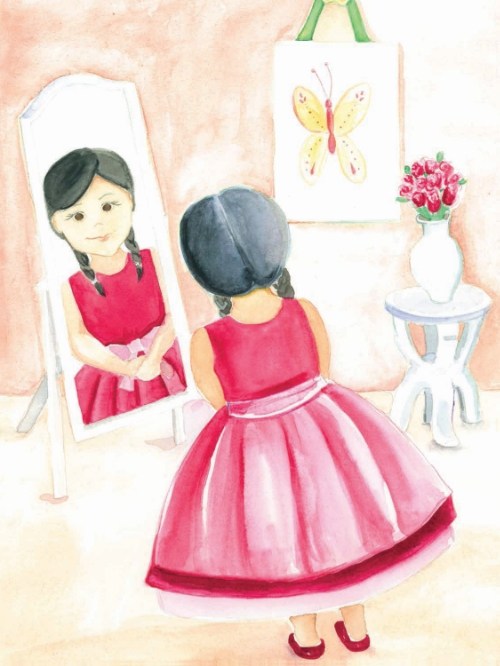
Mei-Mei is understandably excited from the moment she wakes up. On this special day, she gets to wear a beautiful new red dress, and once in the kitchen, she watches and helps her mom cook (taking out the wok, measuring water and pouring it, cleaning the mushrooms, draining the bamboo shoots, adding vegetables to the wok and stirring them). Once her mother combines the noodles with the veggies, Mei-Mei is anxious for a taste, but they must wait for the party guests to arrive. For Mei-Mei, it’s the perfect celebration. After all, there’s nothing better than eating and sharing a dish she helped to make. Mmmm!
The author, Shan-Shan Chen, comes from a long line of restaurateurs, so it’s no surprise that in her debut picture book she played to her strengths, focussing on the step-by-step cooking process, which makes up most of the storyline. She is careful to show which tasks are safe and appropriate for a six-year-old, with Mei-Mei’s mother doing the cutting and slicing prep work and supervising at the stove. However simple, these tasks are empowering to a child doing them for the first time, and Mei-Mei’s sense of pride and accomplishment are palpable.
I was a little puzzled over why Mei-Mei would wear her new dress while cooking and not wait until afterwards to change, but I suppose there are kids who’ll wear their Halloween costumes to bed or refuse to take off a favorite outfit, so maybe it’s my adult practicality speaking.
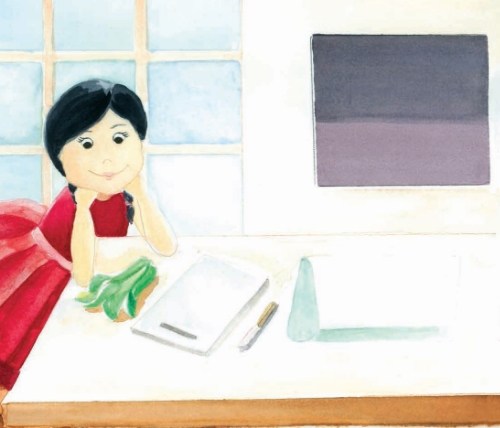
Though I enjoyed Goodman’s lovely watercolors of the stir fry ingredients (bok choy, carrots, green onions, mushrooms), I would have liked to have seen more of Mei-Mei’s family depicted in the illustrations. We never get to actually see mother and daughter cooking together in the kitchen as we read about them. Littlest munchkins who’ll “read” this story mainly through the pictures will see a little girl in the kitchen by herself for the most part and not get that sense of cooking as a bonding experience.
I was also curious to see more of the party guests, especially Mei-Mei’s grandparents, who give her a monetary gift in the traditional red envelope. They are referred to as Nai-Nai and Yei-Yei, but are they Chinese or Caucasian? And where is Mei-Mei’s father, whom we meet in the beginning of the story?
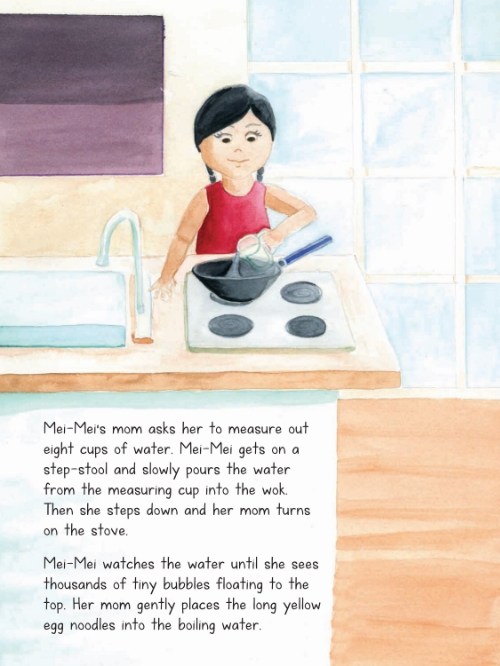
In her introduction, Chen expresses her wish to celebrate Chinese culture, the singular richness of multiracial families, and to foster a love of cooking in younger children. She’s included a recipe for Lucky Birthday Noodles in the back, a nice way for parents and kids to extend their enjoyment of the story and bond over an activity that yields delicious results. I’ve always felt that food is the most accessible and enjoyable way to learn about different cultures, and you can’t beat a hands-on experience. After all, who doesn’t love noodles? 🙂
* * *
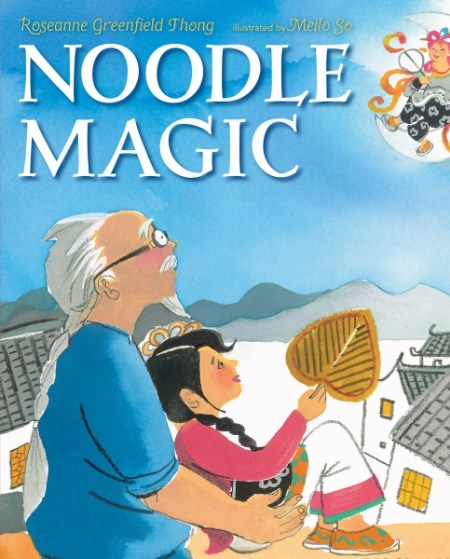
by Roseanne Greenfield Thong
Illustrations by Meilo So
(Orchard Books/Scholastic, November 2014)
Picture Book for ages 4-8, 32 pp.
*
Written in the style of a Chinese folk story, Noodle Magic is a delectable blend of family, community and cultural traditions. Throw in a charming narrative flavored with equal parts wonder and whimsy perfectly captured in vivid, detailed illustrations, and you have a noodly feast readers will want to savor again and again.
Young Mei has always admired the very special magic noodles Grandpa Tu is famous for in their village. She loves helping him make them for special occasions, especially the Emperor’s birthday, when his noodles are even more amazing.
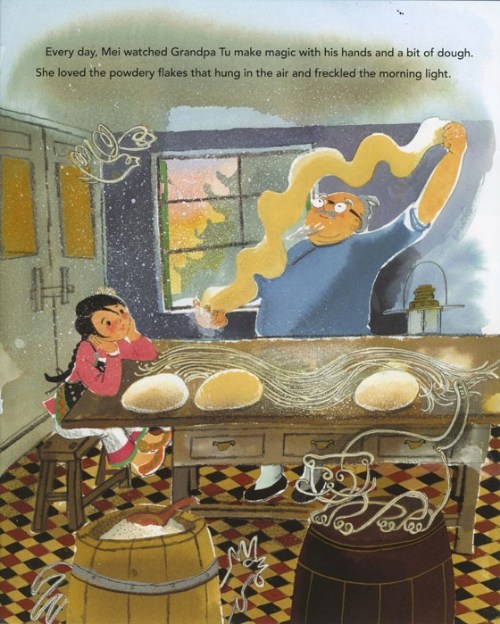
Every evening, as she watches him slap, knead and stretch the dough into long coils, she’d ask him questions like, “Can you make a jump rope from noodles?” And he’d say, “Simple as a sunflower seed.” When a neighbor asks, “How about string for our kites?”, Grandpa Tu would say, “Easy as a sea breeze.” It seemed Grandpa Tu could make anything out of noodles, impressing everyone in the village, even the Moon Goddess watching from above.
On the eve of the Emperor’s birthday, when everyone else is making something special to celebrate, Grandpa Tu tells Mei it’s time she make the long-life noodles herself. She’s terrified, and though she slaps, kneads and stretches the dough just like she’d seen Grandpa do many times, her noodles are ordinary, not magic at all.
Grandpa tells Mei to keep trying, that she already has the magic within, but nothing seems to work. Finally, they pull and stretch and stretch the dough together and Mei rolls it into a big noodle ball, a gift for the Moon Goddess which she tosses skyward. The Moon Goddess is delighted with the gift, but when Mei asks her to send magic, she tells Mei that “magic must come from within.”
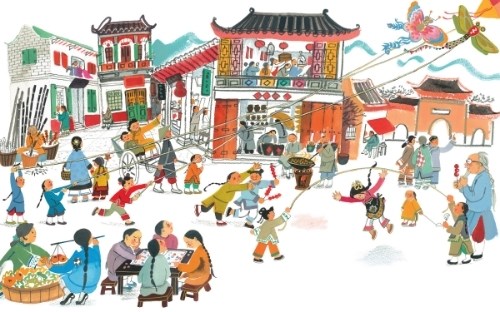
Finally, Mei closes her eyes and thinks hard about everything Grandpa has taught her, and she pulls, pulls, pulls as hard as she can, playing tug-of-war with the Moon Goddess. The noodles stretch and s-t-r-e-t-c-h until they finally SNAP! — sending a huge (yes, magical!) shower of multi-shaped noodles raining down all over the village. Wow! What a heart-soaring, empowering moment!
I do love Thong’s captivating, lyrical narrative, and how she’s portrayed the warm and loving relationship between Mei and Grandpa Tu, with his delightful poetic speech. He is the grandfather every child might wish for, one who can lasso animal-shaped clouds with his noodles, and who provides gentle guidance, encouragement, and inspiration in just the right amounts.
Meilo So has done a beautiful job of depicting all the fascinating village people, their customs and activities. Readers will enjoy poring over the vibrant illustrations, pointing out the fruit, flower and food vendors, the kite flyers, the board game players and all the shoppers, bustling and busy. The dough kneading and stretching scenes brim with vim and vigor pulling the reader right into the action. Kids will also enjoy following the noodly rooster and cat, who appear in almost every spread, a clever reminder of magic in the everyday.
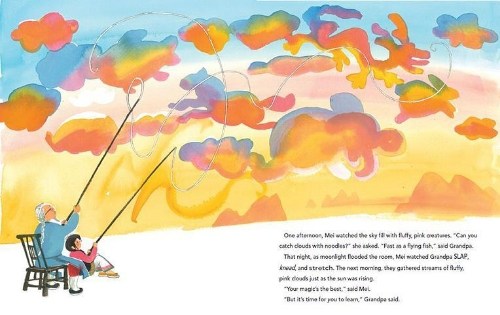
Noodle Magic is a wonderful tribute to lamian noodles, a type made by twisting and stretching the dough by hand into strands. It is believed the world’s oldest noodles (discovered in China and dating back 4000 years), resemble traditional lamian noodles. Magic and wonder aside, this story is a powerful reminder that anything is possible and that we all truly possess the ability to achieve our heart’s desire. So delicious in every way! 🙂
* * *
Now, watch this chef make hand-pulled noodles. Pretty magical, no matter how you stretch it!
* * *
♥ NOODLE AROUND SOME MORE ♥
- Check out my review of Cora Cooks Pancit by Dorina K. Lazo Gilmore and Kristi Valiant
- What about some Noodle Pie by Ruth Starke?
- Don’t miss Plenty Saimin by Feng Feng Hutchins and Adriano F. Abatayo III
- Smack your lips: Spaghetti Smiles by Margo Sorenson and David Harrington
- Pasta and Noodle Picture Book Roundup
HAPPY NOODLE MONTH!
————————————–
*Spreads from Mei-Mei’s Lucky Birthday Noodles posted by permission of the publisher, text copyright © 2014 Shan-Shan Chen, illustrations © 2014 Heidi Goodman, published by Tuttle Publishing. All rights reserved.
**Spreads from Noodle Magic posted by permission of the publisher, text copyright © 2014 Roseanne Greenfield Thong, illustrations © 2014 Meilo So, published by Orchard Books/Scholastic. All rights reserved.
***Copyright © 2015 Jama Rattigan of Jama’s Alphabet Soup. All rights reserved

I love the idea of noodles showering from the sky! And “noodle” is just too much fun to say. Noodle, noodle, noodle. Happy Noodle Month!
LikeLike
I feel the same way about the word noodle. 🙂 Meilo So’s spread showing the noodle shower is wonderful — all shapes and sizes!
LikeLike
I certainly will be taking a look at both of these books Jama. I am thinking noodles for dinner is a good idea. I always, always enjoy your featured book reviews. Thank you for sharing these two titles.
LikeLike
Thanks for stopping by to read, Margie! Hope you have fun noodling around . . . 🙂
LikeLike
These look like fun books!
I was going to ask whether noodles originated in China or in Italy, but it seems that you answered my question. 🙂
LikeLike
Yes, China! Amazing that those noodles survived for that long.
LikeLike
Well, I am fascinated with the noodle pulling, That second book especially looks so sweet. How can one not love a “grandfather every child might wish for, one who can lasso animal-shaped clouds with his noodles”. Thanks, Jama.
LikeLike
The noodle pulling chefs make it look so easy — wonder how long it takes to perfect that technique.
LikeLike
Making noodles that way does seem really hard to me! I expect there is a bit of magic involved…
LikeLike
I agree — very hard and tricky.
LikeLike
Multiple things:
When looking at the pictures for “Noodle Magic,” I thought, “Looks just like the illustrations for ‘White Swan Express‘!” Sure enough – same illustrator. 😀
Like you, I’m wishing there was more emphasis on the fact that Mei Mei is adopted in “Lucky Birthday Noodles,” with pictures of her with her family, because it sounds otherwise like a neat book.
Also, I wanted to tell you that our school librarian finally got some extra book money (not just from Scholastic Book Fair profits), which allowed her to buy books Scholastic doesn’t necessarily carry. When we opened the box, to my delight I found the book on Eleanor Roosevelt and hot dogs (which I had recommended to her) … AND “Dumpling Soup”! Just wanted to let you know that your recommendations (plus your own works) are having a fantastic positive effect on our collections. 😀
LikeLike
I haven’t seen White Swan Express, but will look for it since I love Meilo So’s work!
I think the illustrator missed an opportunity to amplify the author’s intent to celebrate multiracial families. There is a family portrait on the back cover of Mei-Mei with her parents and I think something similar should have been included in the story itself.
I’m so happy that your library bought the Eleanor Roosevelt book and DS! Thanks for suggesting them and thanks for telling me :)!
LikeLike
The Noodle Magic sounds good. The Birthday Noodles book IS good! 😀
LikeLiked by 1 person
Yes, please. All day. Any day.
LikeLiked by 1 person
Hurray for noodles!!! That’s one of my vices. I learned to eat them at will and in large portions as a child–no one stopped me. They are my downfall, including bread. Can’t believe there are books about noodles!!! Yay!!! I’m not so far off after all. Let go of starches and I lose weight. I like to call it a sensitivity. Here’s to the NOODLE! Enjoyed the comfort brought on by noodles but with loved ones this time.
LikeLiked by 1 person